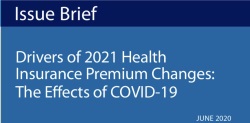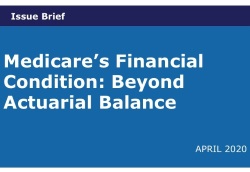HealthCheck, Summer 2020
07/21/2020
 |
|
Summer 2020
VOL 11 | NO 2 |
 health@actuary.org.
health@actuary.org.
HealthCheck did a Q&A with work group member John Schubert, who helped draft the practice note.
This latest revision of ASOP No. 6 became effective in 2015. Why the need for this practice note now? Can you talk a bit about how this practice note was developed?
The answer to the question “why now?” is an interesting story. The drafting of the practice note became like a saga on Netflix! Following the release of the revised ASOP No. 6, there was an awareness that practitioners might welcome a practice note focused on how to develop age-specific claims costs assumptions. In late 2015, in my role as chairperson of the Academy’s Retiree Benefits Subcommittee, I suggested to Colleen O’Malley Driscoll, chairperson of the Employee Benefits Committee, that we gather several seasoned actuaries in the realm of retiree health benefit plans for this purpose. An experienced group of actuaries answered the call to draft a practice note that would provide practitioners with the benefit (pun intended) of their experience in developing age-specific claims costs.
After the work group completed its first draft, we sought the review of two actuaries who specialize in the arena of retiree health benefits: Jeff Petertil and Adam Reese. They provided thoughtful comment, which we incorporated in an interim version. The work group then submitted this version to Academy review. We shared repeated calls to revise the draft and are now submitting the practice note to Academy members for review and comment.
The practice note deals extensively—almost exclusively—with section 3.7.7 of ASOP No. 6. That section is 700 words long. Why, then, does this practice note run to nearly 50 pages—what makes that section of the ASOP so complex?
This section is long because there is much information to digest! Developing a claims costs assumption is a bit like sitting down to an outdoor BBQ buffet. There are many issues to weigh such as claims experience and age/gender distributions and more. Adopting a diet-like approach to developing a claims cost assumption runs the risk of missing the “meal” entirely.
It is important to focus on the requirement in the current version of ASOP No. 6 that an actuary should use age-specific costs in the development of initial per-capita costs in a retiree health benefit valuation. This requirement applies to a signing actuary for a valuation of a fully pooled or non-fully pooled plan. Use of age-specific costs was not required in the previous version of ASOP No. 6 because that standard included only a requirement that actuaries “should consider” the use of aging in setting per-capita costs.
The length of the practice note results from the requirement to use aging in all retiree health benefit valuations, unless an actuary discloses that aging is not needed because the plan aligns with the limited exceptions as described in paragraph 3.7.7(c). There is much good information in the practice note, including illustrative examples. The note has four pages of illustrations related to exceptions, a flowchart of how to find data sources, and 12 pages of methodology examples. We’ve even included the work group’s historical perspective of how the practice of developing claims costs assumptions evolved.
The practice note illustrates that ASOP No. 6 is, in practice, applied differently if the retiree health benefit plan is fully pooled, non-pooled, or partially pooled. In your estimation, which type of plan’s actuaries would benefit most from this practice note?
Short answer: All. All actuaries signing retiree health benefit plan valuations will benefit from this practice note. An actuary valuing a retiree health benefit plan that is not fully pooled is encouraged to request the plan’s own claims experience and age/gender distribution when developing the per-capita claims costs that is the benefit promised in these types of plans. The practice note provides examples of the development of these per-capita claims costs assumptions.
For a plan that is fully pooled, there exists the additional issue of subsidy between one employer participating in the pool and another participating employer. The practice note describes how the common set of premiums are used with the pool’s age/gender distribution to estimate the age-specific costs. It also lists the actions that an actuary might take in obtaining the needed data to understand the age/gender distribution of the pool. The actuary might then spread the common set of premiums for the pool across the pool’s age/gender distribution in order to create an age-graded vector of assumed claims costs.
For partially pooled plans (which are technically classified in ASOP No. 6 as pooled health plans), the actuary may consider the principles and practices outlined for both non-pooled plans and fully pooled plans and create a composite age-graded vector of assumed claims costs.
What are some of the exceptions to the general principle in ASOP No. 6 that for health coverage, benefit costs vary by age? Do you see some of them more frequently than others?
For medical and prescription drug coverage, claims costs generally increase with age, though occasionally age-specific costs at older ages, say 85 years and older, might plateau or even decrease slightly. Other benefits, such as dental coverage, are often valued without regard to aging. This usually occurs because dental coverage is typically limited in the reimbursement of costs for services. Higher reimbursement is typical for periodic, routine services and lower reimbursement for other, major, and restorative services. Dental or vision and hearing coverages are the more frequent exceptions to ASOP No. 6’s requirement to include aging in the development of per-capita claims costs.
Other items, such as short-term projections of an employer’s cash flow premium outlays or retiree benefits provided by individual Medicare Advantage coverages, might be considered exceptions to the general principle of using claims costs that vary by age.
Can you talk a bit about the significance of section 3.7.7(c)(4) of ASOP No. 6, as described in this practice note? How does this section speak to sustainability of retiree health benefit plans?
Section 3.7.7(c) describes some limited exceptions to ASOP No. 6’s requirement to include age-specific costs in the valuation of retiree health benefit plans. A couple of these exceptions are described in the previous question. These exceptions address dental or hearing coverages and short-term cost projections for budgeting purposes.
It is key to focus on section 3.7.7(c)(4). This subsection states that “the use of a premium without regard to adjustment for age is generally inappropriate if the pooled health plan and its premium structure are not sustainable over the measurement period if other groups or active participants cease to participate.” The common set of premiums used to value costs for a pooled health plan is spread over the pooled plan’s age/gender distribution, in order to capture any subsidy from one employer to another within the pool.
The November 2015 guidance from the Actuarial Board for Counseling and Discipline (ABCD) describes more fully the need to support an actuary’s lack of use of aging when valuing a pooled health plan because the actuary has determined that the common set of premiums for a pooled health plan would not change if active participants or other groups cease to participate in the pool. The common set of premiums would generally change if other groups cease their participation in the pool. This is what causes subsection 3.7.7(c)(4) to be quite difficult for an actuary to provide analysis that meets this exception.
What should actuaries do if they have comments or suggestions regarding the exposure draft? Do you anticipate another exposure before the final practice note is released?
This practice note has been in the making for more than four years. Whether another exposure is needed will depend on the breadth and depth of comments received from practitioners. We truly hope that readers will find the material readable and useful and will take the time to provide us with your comments.
Issue Brief Examines COVID-19’s Effect on 2021 Premiums
 As health insurers file proposed premium rates for 2021, a new Academy issue brief was published to describe how the COVID-19 pandemic has brought new uncertainties and complexities to the development of health insurance rates being filed that will determine what insureds will pay next year.
As health insurers file proposed premium rates for 2021, a new Academy issue brief was published to describe how the COVID-19 pandemic has brought new uncertainties and complexities to the development of health insurance rates being filed that will determine what insureds will pay next year.
The issue brief, Drivers of 2021 Health Insurance Premium Changes: The Effects of COVID-19, explains that the coronavirus pandemic will affect 2021 premiums dependent on a number of different assumptions.
“Premium changes are based on how costs of care, enrollment, and other factors are expected to change relative to insurers’ assumptions that were used in setting premiums for the current year, and the COVID-19 pandemic has brought new unknowns and opposing trends into the mix,” said Academy Senior Health Fellow Cori Uccello.
“The pandemic has introduced both positive and negative cost pressures within the health care system, and uncertainties to key projections such as claims that could be sensitive to possible subsequent waves of infection and illness,” she said.
Online Briefing for Capitol Hill Staff
 June 26 online briefing for health policy stakeholders, including congressional staff, in which presenters Barb Klever, chairperson of the Individual and Small Group Markets Committee, and Academy Senior Health Fellow Cori Uccello discussed factors actuaries consider in setting premium rates, how COVID-19 has affected these factors for 2021 rate filings, and potential risk mitigation mechanisms that could address the heightened risks and uncertainties that have arisen during this pandemic. Audrey Halvorson, Academy vice president, health, moderated.
June 26 online briefing for health policy stakeholders, including congressional staff, in which presenters Barb Klever, chairperson of the Individual and Small Group Markets Committee, and Academy Senior Health Fellow Cori Uccello discussed factors actuaries consider in setting premium rates, how COVID-19 has affected these factors for 2021 rate filings, and potential risk mitigation mechanisms that could address the heightened risks and uncertainties that have arisen during this pandemic. Audrey Halvorson, Academy vice president, health, moderated.
Klever and Uccello drew from two Academy issue briefs—Drivers of 2021 Health Insurance Premium Changes: The Effects of COVID-19, and Health Insurance Risk Mitigation Mechanisms and COVID-19—that explore uncertainties brought on by the pandemic.
“How COVID-19 will affect 2021 premiums depends on assumptions related to the persistence of the first [pandemic] wave and the emergence of subsequent waves in 2020 and 2021,” Halvorson said, as well as “shifts in insurance coverage and risk-pool composition, testing and treatment costs, vaccine availably and costs, and other changes to utilization and costs, including those related to telehealth and provider reimbursement rates.” She also noted, with a high level of uncertainty still remaining around COVID-19, insurers will likely run multiple scenarios involving different assumptions.

KleverKlever pointed to COVID-19 having significantly impacted 2020 experience, and that issuers have been monitoring the impact on 2020 claims, while projecting forward throughout the rest of this year and into 2021. She also raised the impacts of job losses on people who had employer-based health insurance, and on the individual and small-group markets.
“The economic downturn could accelerate the trend of lower enrollment in the small group market,” she said, and regarding a potential vaccine, “insurers need to consider the possibility of a vaccine becoming available in 2021, the percent of the population that will receive the vaccine, and the cost.” In addition, she observed the costs of testing will also typically be built into premiums.
Risks and Risk Mitigation
Uccello discussed risks that insurers typically face and how COVID-19 has increased these risks. She went on to examine the potential for risk mitigation mechanisms such as risk corridors and reinsurance to mitigate those risks. She noted that “risk corridors can protect insurers from unusually large losses from COVID-19 and they can target payments to insurers with losses rather than providing payments to all insurers.”
In contrast, reinsurance payments, which can offset insurer costs for high-cost enrollees, would be made regardless of whether an insurer faced unexpected losses overall. “[Medical loss ratio] requirements could provide a backstop on unanticipated insurer gains under either one-sided risk corridors or reinsurance,” Uccello said.
Webinar Covers Rate Filings, COVID-19 Issues
 ACA Rate Filing and Risk Adjustment in the Time of COVID19: A Discussion with Federal and State Regulators.”
ACA Rate Filing and Risk Adjustment in the Time of COVID19: A Discussion with Federal and State Regulators.”
Moderated by Academy Senior Health Fellow Cori Uccello, the panel of regulators highlighted changes in the (then) recently released final Notice of Benefit and Payment Parameters (NBPP) and discussed the potential effects of the coronavirus pandemic on 2021 rate filings, 2020 reporting requirements, and risk adjustment issues for individual and small group plans.
Speakers were David Shea, health actuary with the Virginia Bureau of Insurance; and two representatives from the Centers for Medicare & Medicaid Services’ (CMS) Center for Consumer Information and Insurance Oversight (CCIIO)—Brent Plemons, director of the Office of Special Initiatives and Pricing, and health insurance specialist Allison Yadsko.
“This year, premium rate development is going on amid enormous uncertainty regarding the effects of COVID-19 on health spending both for 2020 as well as for 2021,” Uccello said in introducing the speakers.
Yadsko covered Risk Adjustment Data Validation (RADV) issues, and CCIIO also provided a link for Final 2021 Benefit Year Final HHS Risk Adjustment Model Coefficients, released May 12.
Plemons said there are many factors affecting rates independent of the effects of COVID-19, and that actuaries itemizing such factors through filings would help CCIIO not to have to re-review everything else already submitted. “It will help us—and help you—if everyone can be mindful of things that are likely to change,” he said.
Shea, who gave a state regulator’s perspective, said, “First of all, let’s all acknowledge that at this moment no one is an expert on how COVID-19 will impact health care costs,” added that, referring to comments made by a medical expert who said there is more we don’t know than do know about the novel coronavirus, “I would venture to say the same is true for actuaries.”
He added that with filings “it would be very helpful if companies can clearly show the impact [of the pandemic], explain their assumptions including any external resources or publication used—that will help facilitate timely rate reviews.”
Speakers discussed the final NBPP for 2021, released May 7 by the Centers for Medicare & Medicaid Services (CMS. The guidance contains provisions that insurers can use as blueprints for health plan innovation.
They noted CMS issued in early May a Revised Bulletin: Timing of Submission of Rate Filing Justifications for the 2020.
Prospectively, dates in the timeline include:
- Final rate filings that contain a QHP in the Health Insurance Oversight System Unified Rate Review (HIOS URR) states with exchanges that utilize the Healthcare.gov platform are due on Aug. 26.
- Final rate filings that contain a QHP to both CMS and the state for states with a state-based exchange that does not use the Healthcare.gov platform are due on Oct. 15.
- Final rate filings that only contain non-QHPs in the HIOS URR are also due on Oct. 15.
The final NBPP includes several changes including drug manufacturer coupons, special enrollment periods, and value-based design plans.
A recording of the webinar (the webinar did not include slides) is available via the Academy’s health webinar page, free for logged-in members.
Issue Brief—Risk Mitigation and COVID-19
The Health Practice Council released an issue brief, Health Insurance Risk Mitigation Mechanisms and COVID-19, which notes the coronavirus pandemic is affecting the U.S. health system in numerous ways, many of which will have downstream effects on health insurers and group health benefit plans, and ultimately on health insurance premiums.
“As policymakers consider different risk mitigation mechanisms, it’s important to understand how they would work and what risks they are intended to address,” said Cori Uccello, the Academy’s senior health fellow and primary drafter of the issue brief. “Depending on how they are structured, risk mitigation mechanisms such as risk corridors could help with the increased uncertainty health insurers face due to COVID-19. But they won’t address other risks in the health system such as declining provider revenues and increased pressures on state Medicaid programs.”
The issue brief’s key points include:
- Risk mitigation mechanisms could help address the increased uncertainty health insurers face due to COVID-19.
- One-sided risk corridors can shield insurers from unusually large losses due to COVID-19; two-sided risk corridors would also protect against unusually high insurer gains.
- Reinsurance can offset the costs of high-cost enrollees, regardless of whether the insurer faced unexpected losses.
- Medical loss ratio (MLR) requirements could provide a backstop on unanticipated insurer gains under either one-sided risk corridors or reinsurance.
- Risk mitigation efforts directed at insurers won’t address other risks in the health system, including declining enrollment in employer-sponsored insurance, increased pressures on state Medicaid programs, and declines in provider revenues that threaten their financial stability and patient access.
Cross-Practice COVID-19 Webinar Includes Health Issues
 Capitol Forum webinar regarding known and unknown risks and challenges actuaries may need to focus on that have been brought on by the COVID-19 pandemic.
Capitol Forum webinar regarding known and unknown risks and challenges actuaries may need to focus on that have been brought on by the COVID-19 pandemic.
The Academy’s four practice-area senior fellows presented, along with the chairperson of the ERM/ORSA Committee. This cross-practice perspective is one that the Academy is uniquely qualified to provide to the profession at large given its broad base of members from all practice areas, as well as its mission emphasis on public policy and professionalism that touch the lives of all Americans through the work of its members.

UccelloSenior Health Fellow Cori Uccello gave an overview of COVID-19’s potential impact on health spending, which will be driven by the number of COVID-19 cases, treatment costs, whether there will be additional waves of outbreaks later this year or next year, and perhaps most importantly, the extent to which spending increases due to the outbreak are offset by declines in non-COVID services and treatments.
“Utilization of lower-cost services such as office visits has declined dramatically,” said Uccello. “In addition, non-emergency hospital services, such as provider high-revenue-producing elective surgeries, have also declined.” Depending on how the pandemic continues to play out, total spending could be higher or lower than expected.
Uccello discussed the pandemic’s impact on the individual and group markets, Medicare and Medicaid, and the effects and possible ramifications of people losing their health insurance with their jobs, and noted uncertainty on 2021 premiums. She added the increase in telehealth use during the stay-at-home orders and social distancing as a result of the pandemic may lead to more of its use in the future.
Issue Brief Looks at Annual Medicare Trustees Report
 Medicare’s Financial Condition: Beyond Actuarial Balance, was released in late April shortly after the annual trustees report was released.
Medicare’s Financial Condition: Beyond Actuarial Balance, was released in late April shortly after the annual trustees report was released.
“The exhaustion date for the Hospital Insurance (HI) trust fund remains unchanged over last year’s projection, drawing ever closer, while funding demands from premiums and general revenue for other parts of the program are also tracking upward,” said Academy Senior Health Fellow Cori Uccello. “A big question in many peoples’ minds—which the report acknowledges but does not address—is what effects the COVID-19 pandemic will have on Medicare’s financial condition.”
Key facts about the program’s financial condition brought to light by the trustees’ report include:
- The projected HI trust fund exhaustion date is 2026, unchanged from last year’s Medicare Trustees Report.
- Supplementary Medical Insurance general revenue funding is scheduled to nearly double from 1.7 percent of gross domestic product (GDP) in 2020 to 3.1 percent in 2094.
- Under current law, Medicare expenditures as a percentage of GDP will grow from 3.7 percent of GDP in 2019 to 6.5 percent of GDP in 2094. However, under the Centers for Medicare & Medicaid Services (CMS) Office of the Actuary’s alternative scenario intended to illustrate certain understatement of current-law Medicare cost projections, total Medicare expenditures would increase to 8.6 percent of GDP in 2094.
Academy Continuing to Update COVID-19 Resources Webpage
Annual Meeting & Public Policy Forum—Early Registration Open; Health Sessions Set
Health Breakout Sessions
Below is a summary of health breakout sessions—visit our website to see full descriptions.
COVID-19 and the Future of Health Care Delivery and Payment—This session will explore whether COVID-19 will result in long-term changes to health care delivery and payment, including an increase in telehealth usage, greater provider openness to capitation, and provider consolidation.
A Tour of Health Care Funding Around the World—This session will present findings from schematic diagrams—compiled by the Academy’s Health Practice International Committee, the SOA International Section, and the International Actuarial Association Health Section—to capture the main features of health financing systems for around 30 countries. It will also explore details of specific country funding schemes.
Regulating the Health Insurance Markets—What’s New for 2021—Panelists will discuss the latest regulatory changes affecting coverage in the Affordable Care Act marketplaces, Medicare, and Medicaid.
Early Registration Ends This Month for 2020 LHQ Seminar
Early registration runs through the end of July for the Academy’s 2020 Register by July 31 and save.
In This Issue
- Q&A—ASOP No. 6 Practice Note
- Issue Brief Examines COVID-19’s Effect on 2021 Premiums
- Online Briefing for Capitol Hill Staff
- Webinar Covers Rate Filings, COVID-19 Issues
- Issue Brief—Risk Mitigation and COVID-19
- Cross-Practice COVID-19 Webinar Includes Health Issues
- Issue Brief—Medicare Trustees Report
- Academy Continuing to Update COVID-19 Resources Webpage
- Annual Meeting & Public Policy Forum Health Sessions Set
- Early Registration Ends This Month for 2020 LHQ Seminar
- Legislative/Regulatory Update
- In the News
Following is an update of key health-related federal and state legislative, regulatory, and judicial activity.
Federal Activity
 The U.S. House of Representatives passed legislation June 29 that would build on the Affordable Care Act (ACA) through provisions designed to lower certain health care costs and expand the number of people who are eligible for subsidized health care. H.R. 1425, the Patient Protection and Affordable Care Enhancement Act, also includes several provisions that would reverse certain regulatory measures from the Trump administration, such as increased flexibility on section 1332 state innovation waivers and expanded availability of short-term limited duration plans, among other measures. It is unlikely the Senate will hold consideration on the legislation. For a detailed description, see the Academy alert.
The U.S. House of Representatives passed legislation June 29 that would build on the Affordable Care Act (ACA) through provisions designed to lower certain health care costs and expand the number of people who are eligible for subsidized health care. H.R. 1425, the Patient Protection and Affordable Care Enhancement Act, also includes several provisions that would reverse certain regulatory measures from the Trump administration, such as increased flexibility on section 1332 state innovation waivers and expanded availability of short-term limited duration plans, among other measures. It is unlikely the Senate will hold consideration on the legislation. For a detailed description, see the Academy alert. The Centers for Medicare & Medicaid Services (CMS) released a special trends report on June 25 detailing and analyzing enrollment trends of individuals who signed up for health insurance coverage through Healthcare.gov during a special enrollment period (SEP) during the COVID-19 pandemic.
The Centers for Medicare & Medicaid Services (CMS) released a special trends report on June 25 detailing and analyzing enrollment trends of individuals who signed up for health insurance coverage through Healthcare.gov during a special enrollment period (SEP) during the COVID-19 pandemic. CMS issued a press release June 23 regarding the creation of a new organizational office, the Office of Burden Reduction and Health Informatics, to consolidate CMS’ efforts to reduce regulatory burdens and increase administrative simplicity.
CMS issued a press release June 23 regarding the creation of a new organizational office, the Office of Burden Reduction and Health Informatics, to consolidate CMS’ efforts to reduce regulatory burdens and increase administrative simplicity. Also on June 23, CMS issued a set of FAQs regarding implementing regulations pertaining to the Families First Coronavirus Response Act (FFCRA) and the Coronavirus Aid, Relief and Economic Security (CARES) Act, which were enacted in March. The FAQs, which were jointly prepared by the Department of Labor, the Department of Health and Human Services (HHS), and the Department of the Treasury, address numerous issues related to section 6001 of the FFCRA and section 3202 of the CARES Act. A detailed description of the guidance can be found in the Academy alert.
Also on June 23, CMS issued a set of FAQs regarding implementing regulations pertaining to the Families First Coronavirus Response Act (FFCRA) and the Coronavirus Aid, Relief and Economic Security (CARES) Act, which were enacted in March. The FAQs, which were jointly prepared by the Department of Labor, the Department of Health and Human Services (HHS), and the Department of the Treasury, address numerous issues related to section 6001 of the FFCRA and section 3202 of the CARES Act. A detailed description of the guidance can be found in the Academy alert. On May 29, CMS issued a proposed rule to amend HHS’ Risk Adjustment Data Validation (HHS-RADV) Program. The proposed rule would change two technical aspects of the RADV Program, including the error rate calculation and the application of HHS-RADV results. The Academy sent a letter on RADV to CMS earlier this year.
On May 29, CMS issued a proposed rule to amend HHS’ Risk Adjustment Data Validation (HHS-RADV) Program. The proposed rule would change two technical aspects of the RADV Program, including the error rate calculation and the application of HHS-RADV results. The Academy sent a letter on RADV to CMS earlier this year. The U.S. House of Representatives passed a $3 trillion stimulus package on May 18 to provide funding relief to state and local governments COVID-19 response aid including $500 billion to state governments and $375 billion to local governments. This stimulus package, H.R. 6800, the Heroes Act, was deemed “Phase 4” in a series of coronavirus aid measurers; however, the bill is not expected to be considered in the Senate. A detailed description of the bill can be found in the Academy alert.
The U.S. House of Representatives passed a $3 trillion stimulus package on May 18 to provide funding relief to state and local governments COVID-19 response aid including $500 billion to state governments and $375 billion to local governments. This stimulus package, H.R. 6800, the Heroes Act, was deemed “Phase 4” in a series of coronavirus aid measurers; however, the bill is not expected to be considered in the Senate. A detailed description of the bill can be found in the Academy alert. CMS released the final HHS Risk Adjustment Model Coefficients for the 2021 benefit year, as the coefficients were not included in the HHS Notice of Benefit and Payment Parameters for 2021. Additionally, CMS published an update to the International Classification of Diseases (ICD)-10 HHS Condition Categories (CC) Crosswalk, reflecting changes made between the proposed 2021 Payment Notice and the final 2021 Payment Notice.
CMS released the final HHS Risk Adjustment Model Coefficients for the 2021 benefit year, as the coefficients were not included in the HHS Notice of Benefit and Payment Parameters for 2021. Additionally, CMS published an update to the International Classification of Diseases (ICD)-10 HHS Condition Categories (CC) Crosswalk, reflecting changes made between the proposed 2021 Payment Notice and the final 2021 Payment Notice. On April 27, the U.S. Supreme Court issued a ruling requiring the federal government to pay $12 billion to health insurers under the risk corridors program of the ACA. In the case of Maine Community Health Options v. United States, the court found the government responsible for providing mitigation funding for the involved health insurers as guaranteed by the original measure, despite HHS spending restrictions imposed by Congress shortly after the ACA was enacted. A detailed description of the court’s ruling can be found in the Academy alert.
On April 27, the U.S. Supreme Court issued a ruling requiring the federal government to pay $12 billion to health insurers under the risk corridors program of the ACA. In the case of Maine Community Health Options v. United States, the court found the government responsible for providing mitigation funding for the involved health insurers as guaranteed by the original measure, despite HHS spending restrictions imposed by Congress shortly after the ACA was enacted. A detailed description of the court’s ruling can be found in the Academy alert. President Trump a signed a bill into law April 24 providing additional emergency relief in response to the financial impacts caused by the COVID-19 pandemic. H.R. 266, the Paycheck Protection Program and Health Care Enhancement Act, contained extended appropriations to many health and economic relief programs, building on funding measures provided by the CARES Act, H.R. 748, which was signed into law in March. In addition, Congress passed additional pandemic-related legislation earlier this year including H.R. 6201, the Families First Coronavirus Response Act, and H.R. 6074, the Coronavirus Preparedness and Response Supplemental Appropriations Act of 2020. A detailed description of the most recent legislation, H.R. 266, can be found in the Academy alert.
President Trump a signed a bill into law April 24 providing additional emergency relief in response to the financial impacts caused by the COVID-19 pandemic. H.R. 266, the Paycheck Protection Program and Health Care Enhancement Act, contained extended appropriations to many health and economic relief programs, building on funding measures provided by the CARES Act, H.R. 748, which was signed into law in March. In addition, Congress passed additional pandemic-related legislation earlier this year including H.R. 6201, the Families First Coronavirus Response Act, and H.R. 6074, the Coronavirus Preparedness and Response Supplemental Appropriations Act of 2020. A detailed description of the most recent legislation, H.R. 266, can be found in the Academy alert.
State Activity
Several states have implemented legislation in response to the COVID-19 pandemic and its impact on health care delivery, for instance:
 North Carolina Gov. Roy Cooper signed two bills into law to address the state’s response to the COVID-19 pandemic. SB 808, Medicaid Funding Act, appropriates funding through the state’s Medicaid program for coronavirus testing and contact tracing. SB 704, COVID-19 Recovery Act, provides for priority testing to front-line workers and increases telehealth access and services under the state’s Medicaid program. An actuarial impact summary of the latter bill can be found here.
North Carolina Gov. Roy Cooper signed two bills into law to address the state’s response to the COVID-19 pandemic. SB 808, Medicaid Funding Act, appropriates funding through the state’s Medicaid program for coronavirus testing and contact tracing. SB 704, COVID-19 Recovery Act, provides for priority testing to front-line workers and increases telehealth access and services under the state’s Medicaid program. An actuarial impact summary of the latter bill can be found here. Colorado Gov. Jared Polis signed a bill into law on June 29 regarding the state’s allocation and handling of appropriations received from the FFCRA.
Colorado Gov. Jared Polis signed a bill into law on June 29 regarding the state’s allocation and handling of appropriations received from the FFCRA. Florida Gov. Ron DeSantis signed a bill into law on June 19 making changes to rules governing long-term care facilities including allowing for the rescreening of high- and low-priority scored individuals and providing community-care-for-the-elderly services to dispute certain referrals. Additional state legislative and regulatory COVID-19 guidance was published in the Academy’s Spring StateScan Quarterly.
Florida Gov. Ron DeSantis signed a bill into law on June 19 making changes to rules governing long-term care facilities including allowing for the rescreening of high- and low-priority scored individuals and providing community-care-for-the-elderly services to dispute certain referrals. Additional state legislative and regulatory COVID-19 guidance was published in the Academy’s Spring StateScan Quarterly.
An AIS Health story quoted Academy Senior Health Fellow Cori Uccello on how the COVID-19 pandemic may differently affect cities in different areas of the country. A Bloomberg Law article quoted Uccello on uncertainty in health costs brought on by the COVID-19 pandemic, due in part to variability of deferrals in non-COVID-19 care. Uccello also co-authored an article in the JAMA Health Forum on an option to lower the Medicare eligibility age and the challenges that it would bring to an already complex health care system.
Several media outlets, including Bloomberg Law, Fierce Healthcare, BenefitsPro, Becker’s Hospital Review, Advisor Magazine, and Healthcare Dive, cited the Individual and Small Group Markets Committee’s issue brief that outlines the major factors driving premium changes for 2021, including the impact of COVID-19.
Health Payer Intelligence and BenefitsPro cited the Academy’s issue brief on risk mitigation mechanisms in the wake of COVID-19 in a piece on risk corridors and reinsurance.
Nashville Medical News reported on the Academy’s JD Supra also reported on the FAQs.
Advisor Magazine highlighted the Academy’s issue brief on Medicare’s financial condition based on the 2020 Medicare Trustees Report.
An SHRM story cited findings from the Academy’s research paper, Estimating the Potential Health Care Savings of Reference Pricing.
|
Copyright © 2020 American Academy of Actuaries. All Rights Reserved. |
 www.actuary.org/coronavirus
www.actuary.org/coronavirus Phone: 202-223-8196
Phone: 202-223-8196